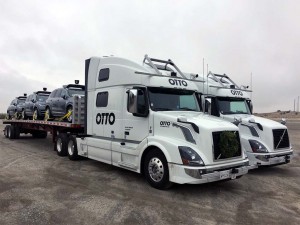
Uber Freight is testing autonomous trucks in Arizona to see what their capabilities are and what system may work best for them.
Uber has moved from testing its self-driving cars in select markets to now putting its autonomous trucks through their paces on delivery runs in Arizona.
According to the company, it began its program in November, including contracting with trucking companies to use its own autonomous Volvo big rigs to take over loads as they traverse the state.
The program calls for a trucker to meet the self-driving truck at the Arizona state border, which then takes the load across the state before handing it off to a second conventional trucker for the short-haul trip. During the autonomous trip, an Uber employee rides in the driver seat of the autonomous truck to monitor the truck and would only need to drive in the event of an emergency.
There is no timetable for how long the trucks will remain in the testing phase of the program. Part of issue with the setup as configured is that the company is trying to determine if the current is the best way to tackle it.
(Teamsters set up road blocks to autonomous semi trucks. Click Here for the story.)
However, the testing protocol is helping to determine if this solution is best. If so, then self-driving trucks would long-haul highway legs autonomously. They would meet up with actual truck drivers at transportation hubs who would finish the trek into the cities.
The other possibility is Uber could sell its technology to trucking owner-operators, who then use it to sleep while the truck handles the bulk of long-distance driving. This would help truckers better manage the amount of time they are driving.
Truckers are only allowed to a certain number of hours each day behind the wheel, by federal law, and when they meet that maximum, they must pull over and rest for another mandated amount of time.
(Click Here for more about the shortage of truck drivers.)
“The big step for us recently is that we can plan to haul goods in both directions, using Uber Freight to coordinate load pickups and drop offs with local truckers,” said Alden Woodrow, who leads Uber’s self-driving truck effort. “Keeping trucking local allows these drivers to make money while staying closer to home.”
Another way these trucks may help is with the current shortage of long-haul drivers, about 50,000, and that is expected to rise past 100,000 in less than a decade, says the American Trucking Associations.
“It’s a very good highway logistics solution,” Michael Ramsey, autonomous vehicles analyst with Gartner Inc., told Trucks.com. “Instead of just saying ‘Hey, can we do this,’ they are looking at a real problem and addressing it.”
(To see more about an autonomous beer run, Click Here.)
Uber’s focus on the trucker shortage is a more productive approach than tackling the complex issues surrounding last-mile delivery by autonomous truck, Ramsey said.

Big difference between autonomous trucks and autonomous cars is the number and severity of the innocent victims.